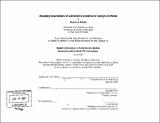| dc.contributor.advisor | George Stiny. | en_US |
| dc.contributor.author | El-Khaldi, Maher (Maher Sami) | en_US |
| dc.contributor.other | Massachusetts Institute of Technology. Dept. of Architecture. | en_US |
| dc.date.accessioned | 2007-10-22T17:35:46Z | |
| dc.date.available | 2007-10-22T17:35:46Z | |
| dc.date.copyright | 2007 | en_US |
| dc.date.issued | 2007 | en_US |
| dc.identifier.uri | http://hdl.handle.net/1721.1/39323 | |
| dc.description | Thesis (S.M.)--Massachusetts Institute of Technology, Dept. of Architecture, 2007. | en_US |
| dc.description | Page 123 blank. | en_US |
| dc.description | Includes bibliographical references (p. 121-122). | en_US |
| dc.description.abstract | Architects have been experimenting with generative systems for design without a clear reference or theory of what, why or how to deal with such systems. In this thesis I argue for three points. The first is that generative systems in architecture are implemented at a skin-deep level as they are only used to synthesize form within confined domains. The second is that such systems can be only implemented if a design formalism is defined. The third is that generative systems can be deeper integrated within a design process if they were coupled with performance-based evaluation methods. These arguments are discussed in four chapters: 1- Introduction: a panoramic view of generative systems in architecture and in. computing mapping their occurrences and implementations. 2- Generative Systems for Design: highlights on integrating generative systems in architecture design processes; and discussions on six generative systems including: Algorithmic, Parametrics, L-systems, Cellular Automata, Fractals and Shape Grammars. 3- Provisional taxonomy: A summery table of systems properties and a classification of generative systems properties as discussed in the previous chapter 4- Conclusion: comments and explanations on why such systems are simplicity implemented within design. | en_US |
| dc.description.statementofresponsibility | by Maher El-Khaldi. | en_US |
| dc.format.extent | 123 p. | en_US |
| dc.language.iso | eng | en_US |
| dc.publisher | Massachusetts Institute of Technology | en_US |
| dc.rights | M.I.T. theses are protected by copyright. They may be viewed from this source for any purpose, but reproduction or distribution in any format is prohibited without written permission. See provided URL for inquiries about permission. | en_US |
| dc.rights.uri | http://dspace.mit.edu/handle/1721.1/7582 | |
| dc.subject | Architecture. | en_US |
| dc.title | Mapping boundaries of generative systems for design synthesis | en_US |
| dc.type | Thesis | en_US |
| dc.description.degree | S.M. | en_US |
| dc.contributor.department | Massachusetts Institute of Technology. Department of Architecture | |
| dc.identifier.oclc | 173319443 | en_US |
